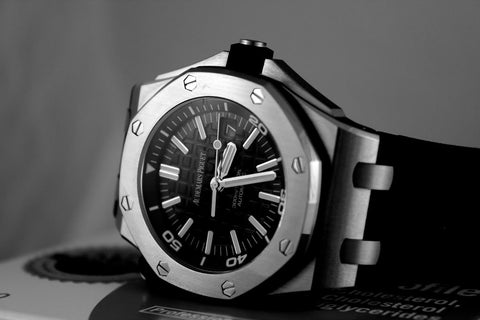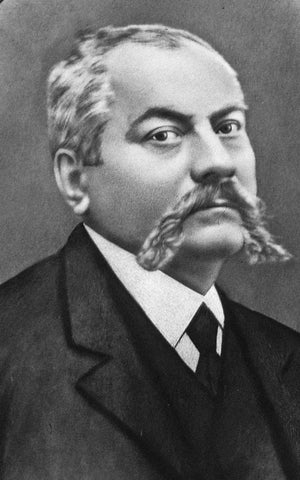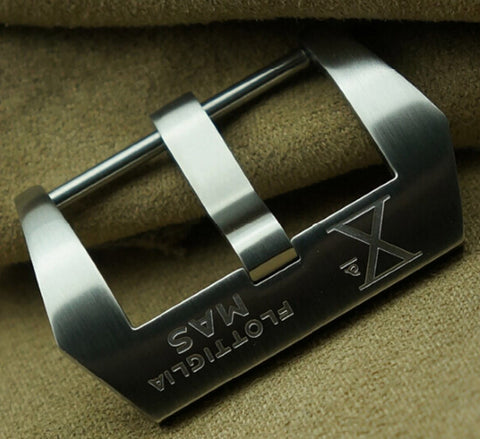Rolex, Tudor: The Untold History of Rolex and Tudor
Rolex, Tudor: The Untold History of Rolex and Tudor uncovers sibling rivalry, secret alliances, and designs that reshaped luxury timekeeping.
Continue readingRolex, Tudor: The Untold History of Rolex and Tudor uncovers sibling rivalry, secret alliances, and designs that reshaped luxury timekeeping.
Continue readingLuxury watches like Rolex, Omega, and AP are timeless — but here’s the secret: it’s the strap that transforms your watch from “classic” to “show-stopping.”
Continue readingDive into The history of FKM rubber & how its made, from aerospace origins to modern seals, with a clear look at chemistry, curing, and performance secrets.
Continue readingExplore Breitling's journey from humble origins to global trendsetters; discover the legacy of innovation and style in the world of luxury watches.
Continue readingDiscover the Omega Moonwatch's journey from history to space, unraveling its timeless legacy that continues to captivate adventurers and watch lovers alike.
Continue readingWhen it comes to luxury timepieces, IWC is a brand that stands out. With a rich history dating back to 1868, IWC has established itself as a leader in the world of horology. In this blog post, we will explore the captivating journey of IWC watches, from their humble beginnings to their status as a symbol of elegance and precision.
Continue reading
Tissot has become a staple wristwatch for plethora folks around the globe. That is, to say the least, putting it mildly. With millions of watches sold annually each year, Tissot is an inescapable name that denotes a fair price and solid engineering.

Charles-Félicien Tissot and Charles-Émile Tissot.
Originating in Switzerland (like many famed watch brands), Tissot launched as a father-and-son operation in 1853. The combined labors of Charles-Félicien Tissot and his son Charles-Émile entered the watchmaking scene in Le Locle Switzerland, located in the Jura mountains. What’s often referred to as the “watch valley”—covering the Swiss Jura Arc from Geneva to Switzerland—was really hitting its stride as Europe’s premiere watchmaking locale during the 19th century. Though this area of Switzerland had a history with timekeeping dating back to the 15th century, more families began planting their flags and sending their products into a growing international market at this time.
What the Tissots had to offer at launch was a two-time-zone pocket watch. They certainly weren’t the first to project this kind of mechanical prowess onto the world—but its craftsmanship and expert construction would sew the seeds for a series of future successes. Within the century Tissot would become presidential, international, and well on its way to fresh innovations.
1853-1899
After releasing their first watches in 1853 Tissot began crafting pendant watches for the U.S. market. In 1858, just five years after their establishment, father-and-son Tissot landed their pendant watches in the States—to fair success. It was in 1858, as well, that Charles-Émile (son) ventured to spread their family name across the Russian empire. Appealing to two of the world’s largest markets for European export watches worked out well for Tissot. What’s more, they established themselves as a company that could make watches that appealed to both men and women. Their pendant watches alone made Tissot synonymous with catering to a variety of horological tastes.

It took a little longer for an 1878 release of Tissot’s pendant-style watches on the Russian market—but they were just as well received as any pocket watches they were selling in that country. Almost one decade later, in 1887, Tissot’s international appeal paid off in a very presidential way. It was in that year they were charged with designing a pocket watch for Swiss President Numa Droz. In three short decades the Tissot family was curating a fine dynasty.
1900-1950s
Tissot’s early years helped establish their name on a growing global market. When the 20th century came roaring in, so did opportunities for adapting new styles to the brand. A new era saw a surging demand for wristwatch time pieces. This rising influence spawned a 1916 classic for Tissot—the Banana. Its arched rectangular case design and oblong-shaped Arabic numerals matched a growing trend toward art deco inspired fashion in watchmaking. What’s more, it was an early wristwatch from Tissot—and it became an immediate classic. Through the 1920s Tissot would cling to this modernizing bend toward avant-garde wristwatches. However, one of watchmaking’s powerful firsts would be born from Tissot come 1930.
1930 marked the release of the world’s first non-magnetic watch. Labeled the “Antimagnetique” (very clever) Tissot’s creation addressed the issue of loss-of-time due to electromagnetic field influence. It was in this same year that Tissot merged with Omega. Their combined efforts lead to a long relationship with building stopwatches for sporting events. This included major skiing events in Switzerland, as well as other major international tournaments.
By the 1940s Tissot began running their first filmed advertisements in cinemas. These ads became the norm and had a massive appeal to a new generation that was growing up on wristwatches. Through this decade, Tissot and Omega (as a combined force) continued to take sporting events by storm, while retaining the stylistic integrity of current watchmaking fashion.
Turning up the heat on simplified user interfaces, Tissot dropped another gem in the year 1951. Their “Navigator” wristwatch employed the first-ever 24-Time-Zone piece that required zero manipulation to read. This attention to detail on streamlining user interfaces would lead them toward further developing a renown of both quality and stylistic flair.
1960-Present
Once the 1960s hit Tissot had become highly dialed-in to their popularity in the racing world. In 1965, combining their relationship with sports and stylistic evolution, they patented the first ever watch strap with holes (designed for fashion). Mirroring the steering wheels on race cars, Tissot portrayed retro-futurism and a penchant for racing sports in this unique release. Futurism gripped the watchmaking world through the 1960s and 1970s. With the space race fresh on the minds of the world’s watch wearers, rising interest in new technologies took hold of the globe. A stark reality of this rising tide toward automation—for brands like Tissot—was the eventual release of electronically powered wristwatches. By the 1980s Tissot, alongside other major Swiss mechanical brands, suffered major monetary losses. In 1983 Tissot was thus purchased by the Swatch watch group—a reality that stands to this day. After Tissot was picked up by Swatch they began releasing novelty pieces under the Tissot brand name. 1985 saw the release of a “rock” watch made almost entirely out of stone (aside from the movement and band). 1989 saw the release of a wood watch from Tissot—a now trendy form of case design that they predicted quite well.
Under Swatch, the greatest current success one can cite for Tissot is their “T” series. Combining their history of sporting prowess and fluid appeal among audiences of all genders, Tissot put both feminie and masculine styles into this line. Applying their years of unique innovation to quartz watchmaking, with their name in the hands of Swatch, Tissot would birth the crown jewel of their quartz series—the Tissot “T-Touch”. Being the first tactile (touch) screen Swiss watch, the T-Touch took on a life of its own in the world of horology. After its 1999 debut the T-Touch would go on to take a variety of new forms; Solar-powered and sports-oriented T-Touch watches continue to remain popular to this day.
Innovations by Tradition
While it could be easy to dismiss Tissot as another Swatch brand—a powerful Swiss name cheapened by the success of quartz—there’s more to it than that. Tissot still exists because of their adaptations to changes in watchmaking. If they had not joined other Swiss companies in the 19th century in trying to grow and evolve watchmaking, the world of watches would be at a loss. Still running on their motto, “Innovations by Tradition”, Tissot remains a tour-de-force name in the watchmaking world. While the father-and-son origins of the brand seem miles away from their current standing, it was that original hustle and spirit that’s laid Tissot watches on the wrists of Presidents and everyday people alike. Tissot is more than a safe mid-range watch—to put it another way. After nearly two centuries of staying on top of trends and bringing their own flair to watch design, they are a historically significant brand that’s worth the attention they retain. Perhaps another tactile surprise may come from them as the world of watches moves into the future. Until then, their ability to blend tradition with current trends will continue to inspire millions of purchases around the globe.
Strapmeister is proud to take inspiration from these watches, as their design permits a great range for innovation and creativity, when considering accessorizing with different straps. It is clear to even the untrained eye, these watches are of extremely desireable merit and quality, and Strapmeister's designs offer high-quality material, comfort, and proud background. Wear Tissot with Strapmeister straps!
Continue readingAudemars Piguet was founded in 1875 by Jules-Louis Audemars and Edward-Auguste Piguet. Childhood friends, Audemars was 23 years old and Piguet 21 at the inception of their watchmaking exploit. Jules-Louis asked Edward-August to work together with him to establish watch movements, and as the pair worked together, they went on to have great success. Their customers were happy. Whether or not either of them knew of their talent and capability to design such excellence, the two Swiss watchmakers made their way onto the plains of horological prestige.

Today, their brand produces in three production sites - La Brassus, Le Locle and Meyrin in Switzerland. The company is comprised of 18 boutiques and 14 distribution subsidiaries worldwide, with 1450 emplyees.
In April 1972, Gérald Genta invented the Royal Oak model, in preparation for the annual watch-making fair in Basal, Switzerland.
In 1992, Emmanuel Gueit designed the Royal Oak Offshore, in celebration of the Royal Oak's 20th anniversary. These watches have since become a favourtie among many haute horology afficionados.
An "extreme" sport version of the Royal Oak, the 42mm case made this an "oversized" watch, although nowadays such a size is not at all unusual.
Featuring a 300m water resistances and materials such as carbon and rubber, the Royal Oak Offshore was also known as "the Beast". This branch of the Audemars Piguet watches is one definitely to be noted, as they really are something special. Three Royal Oak Offshore models are the Ceramic Diver, the Forge Carbon Diver, and the Steel Diver. These watches take credit for the inspiration of Strapmeister's Audemars Piguet strap selection.
The Ceramic Diver has a ceramic black case. The dial is black and has a tough looking "Mega Tapisserie" pattern. The minutes hand is orange, along with the 60 to 15 mark on the roating inner bezel.
The Carbon Diver specs are similar, but with a forged carbon case. The minutes hand and 60 t o15 bezel-mark is yellow. Background Pattern is Mega Tapisserie.

The Steel Diver has a hardy stainless steel case and rubber-clad screw-locking crown. Background pattern is also Mega Tapisserie.

Audemars Piguet watches are without a doubt among the greats when considering mechanical complexity and meticulous craftsmanship. Haute horology is an arena of notable contenders, and if you're wanting for a high grade of excellence, well you need not look much further than the Royal Oak Offshore.
Strapmeister is proud to take inspiration from these watches, as their design permits a great range for innovation and creativity, when considering accessorizing with different straps. It is clear to even the untrained eye, these watches are of extremely desireable merit and quality, and Strapmeister's designs offer high-quality material, comfort, and proud background. Wear your Royal Oak Offshore with Strapmeister straps!
Panerai is undertoned and known for its association with the Decima Flottiglia Mas, the Italian Commando Frogmen. Pioneers of the underwater wristwatch, Panerai provided high-calibre instruments to the Regia Marina (the Italian Royal Navy). The inception of the brand dates back to as early as 1860, in Florence, and the watchmakers soon began development for the Regia Marina.0 The workshop was operated by Guido Panerai - the grandson of the founder, Giovanni Panerai.

The horological prowess of the Panerai name was exhibited in World War 1; ship's clocks and machanical calculators, used for precision firing of torpedoes. Also among the inventory of the Regia Marina, thanks to Panerai, were luminous devices for use of naval night-gunning, and various types of high-precision timers, depth-measurement devices and compasses. The underwater commando, the Decima Flottigla Mas, were heavily in association with Panerai.

The Flottigla Mas was regarded as highly infamous prior to and during World War II, for their devastatingly effective underwater-combat operations. They were Sappers, Divers, and Frogmen, particularly known for their intimidating “manned torpedoes”.

Quite arguably, the first true diving-watch is the Panerai Radiomir. The prototype was produced in 1936 and, after a lot of testing, went into full production in 1938. The watch movements were specially made for Panerai by Rolex. The Flottiglia Mas wore and utilized the Radiomir, crafted with a luminous dial and Perspex crystal. This was highly viable and reliable item of equipment; a notable part of Flottiglia Mas' impressive inventory. The Radiomir was later replaced by the Luminor, which featured a locking crown guard lever.
Over the course of more than four more decades, Panerai kept producing watches and other equipment for the military, and in 1993 released a limited edition collection for public purchase. This collection was to commemorate and pay tribute to the models of their military history. It was an era never to be forgotten, and Panerai knew this, so they shared it with the general public.
Panerai continues producing stunning models today, with design focused on its rich and iconic military history. Largely, these are high-end watches that are meant for the upper-reaches of the luxury market.
At Strapmeister, we provide finely crafted straps and buckles that pays homage to this watches. Our “Flottiglia Mas Tang Buckle” is an excellent investment, as it's commemorative nature is sure to be an exemplary compliment to the notorious exploits of the Decima Flottiglia Mas.

As can be seen in our product picture, this finely brushed steel buckle pays tribute to the Panerai-Flottiglia Mas Reputation. Engraved boldly, coming in three sizes, it is perfectly viable as an expression of admiration of the Decima Flottiglia Mas, the extraordinary operatives of underwater combat.
Continue reading